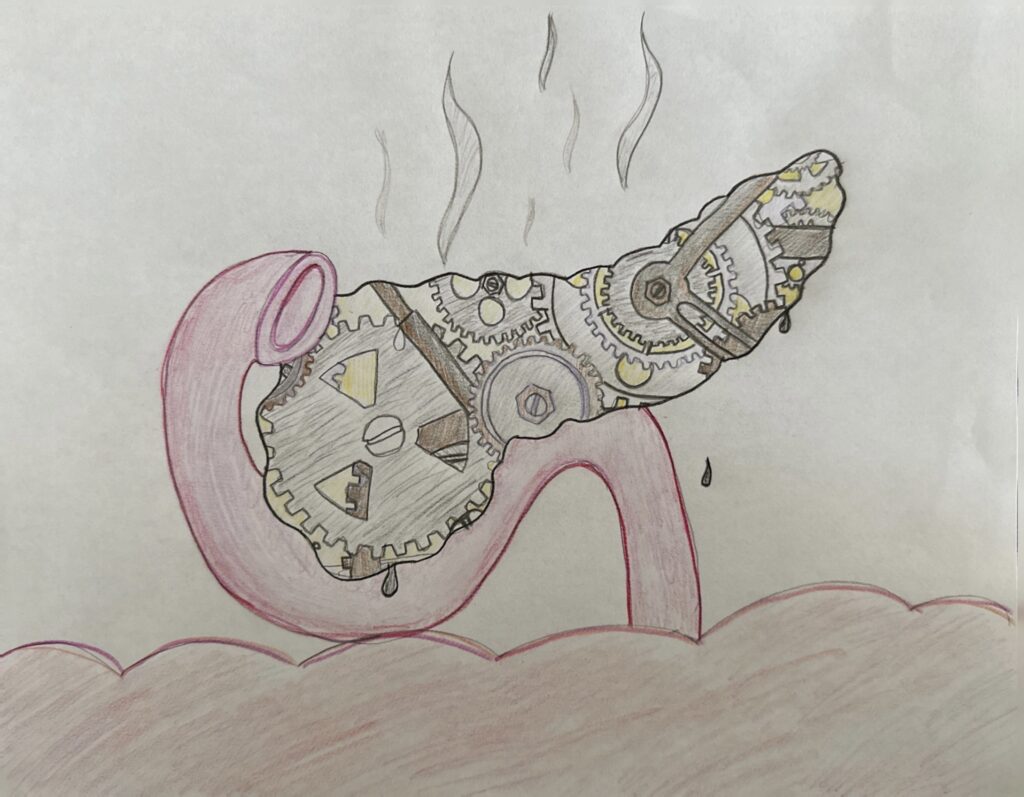Type 2 diabetes is a metabolic disorder that causes glucose to accumulate in the blood due to the lack of insulin production. The main driver of this disease comes from the global rise in obesity, sedentary lifestyles, and high-caloric diets. T2DM is becoming increasingly more of a threat to our population as we continue to dive deeper into our current sedentary lifestyle, the global rise in obesity, and our high-caloric diets. According to the International Diabetes Federation (IDF), in 2019, diabetes caused 4.2 million deaths; and 463 million adults aged between 20 and 79 years old were living with diabetes. They are predicting that the rate will raise by up to 700 million people who will have a case of this metabolic disorder by 2045.
When we eat food our digestive system breaks down the substance into nutrient molecules that are then absorbed into our digestive tract. All of our organs play a vital role in processing and aiding one another in this system to effectively fuel our body through ingestion, propulsion, mechanical or physical digestion, chemical digestion, absorption, and defecation. The pancreas is a part of the accessory organs that provide further support for the alimentary tract. In this case, foods containing sugar and carbohydrates are broken down into glucose, which is important to fuel our bodies. Our pancreas secretes a hormone called insulin by the pancreatic β-cells, a chemical messenger for glucose to go into the cells from the blood, which is essential to using glucose as a fuel source and glucose homeostasis. Insulin does this by being put into the bloodstream where it moves the glucose into glucose channels of the cell when the blood glucose levels rise after a meal. Type 2 diabetes is prevalent when the insulin receptors become resistant to insulin and ignores the message to bring glucose through the receptors which cause an overload of the nutrient in the blood for it to have nowhere to go. This occurs when “adipose tissue promotes insulin resistance through inflammatory mechanisms including increased free fatty acid release and adipokine deregulation” (Int J Mol Sci.). This can lead to β-cell damage in the pancreas due to obesity-induced metabolic and oxidative stress from lipotoxicity, glucotoxicity, and glucolipotoxicity. Another factor that can lead to T2DM is the overall lack of the production of the hormone from the pancreas constantly being overworked and just like any other working machine, stops functioning correctly over time (what I depicted in my illustration).
Those who live with this condition suffer many symptoms such as frequent urination and excessive thirst, weakness, drowsiness, and blurred vision. It is important to treat T2DM because it can cause damage to the small blood vessels over time which can lead to further chronic conditions including vision problems, nerve damage, and kidney disease. If there is damage in the larger blood vessels this can cause heart disease, strokes, and poor blood circulation. Some people have a higher susceptibility to getting this disease such as those who suffer from prediabetes, are overweight, are 45 years or older, family history of diabetes, are physically active less than 3 times a week, have diabetes during pregnancy, or have been given birth to a baby who weighed over 9 pounds. There are ways to prevent it like keeping weight under control, exercising more, eating a healthy diet, and not smoking. It all dwindles down to the behavior and dedication to the individual to discipline themselves to keep a healthier lifestyle, but once you’ve overworked your pancreatic system there’s no going back.
Works Cited:
Galicia-Garcia U, Benito-Vicente A, Jebari S, Larrea-Sebal A, Siddiqi H, Uribe KB, Ostolaza H, Martín C. Pathophysiology of Type 2 Diabetes Mellitus. Int J Mol Sci. 2020 Aug 30;21(17):6275. doi: 10.3390/ijms21176275. PMID: 32872570; PMCID: PMC7503727.
Satin LS, Butler PC, Ha J, Sherman AS. Pulsatile insulin secretion, impaired glucose tolerance and type 2 diabetes. Mol Aspects Med. 2015 Apr;42:61-77. doi: 10.1016/j.mam.2015.01.003. Epub 2015 Jan 28. PMID: 25637831; PMCID: PMC4696552.
Colagiuri, S., Borch-Johnsen, K., Glümer, C. et al. There really is an epidemic of type 2 diabetes. Diabetologia 48, 1459–1463 (2005). https://doi.org/10.1007/s00125-005-1843-y


This STEAM project by Abigail Sloan highlights Diabetes Mellitus type 2, or DMT2. Abigail informs us that DMT2 is caused by predisposition, genetics, age, pregnancy, obesity, bad fitness, a high-caloric diet, and smoking. The International Diabetes Federation estimates that in a couple decades, diabetes will plague 700 million people. Abigail tells us what diabetes does and how we can prevent it.
We can get Diabetes if our blood sugar levels get out of balance. Glucose is a body fuel we use up gradually; pancreatic β cells secrete the hormone insulin which binds to receptors on cells, allowing excess glucose to pass through for storage, to be taken out at a later date. An indulgent lifestyle stands poised to sabotage this system: excess fat releases fatty acids and deregulates adipokine, making cell receptors ignore insulin and keep glucose out. High blood sugar damages the β cells in the pancreas, overworking our pancreas by eating too much sugar causes it to shut down. Diabetes can cause blurred vision, frequent urination, thirst, weakness, and drowsiness. Blood vessel damage leads to nerve damage and kidney disease, heart disease, stroke, and poor circulation. Limiting calories, exercising, and not smoking reduce the risk of developing a quite common, preventable disorder.
Abigail drew the small intestine attaching to the pancreas which is filled with mechanical gears. Her drawing shows the effect of excess blood sugar on the pancreas, we see smoke rising and oil dripping from the pancreas, telling us that it is at the breaking point.